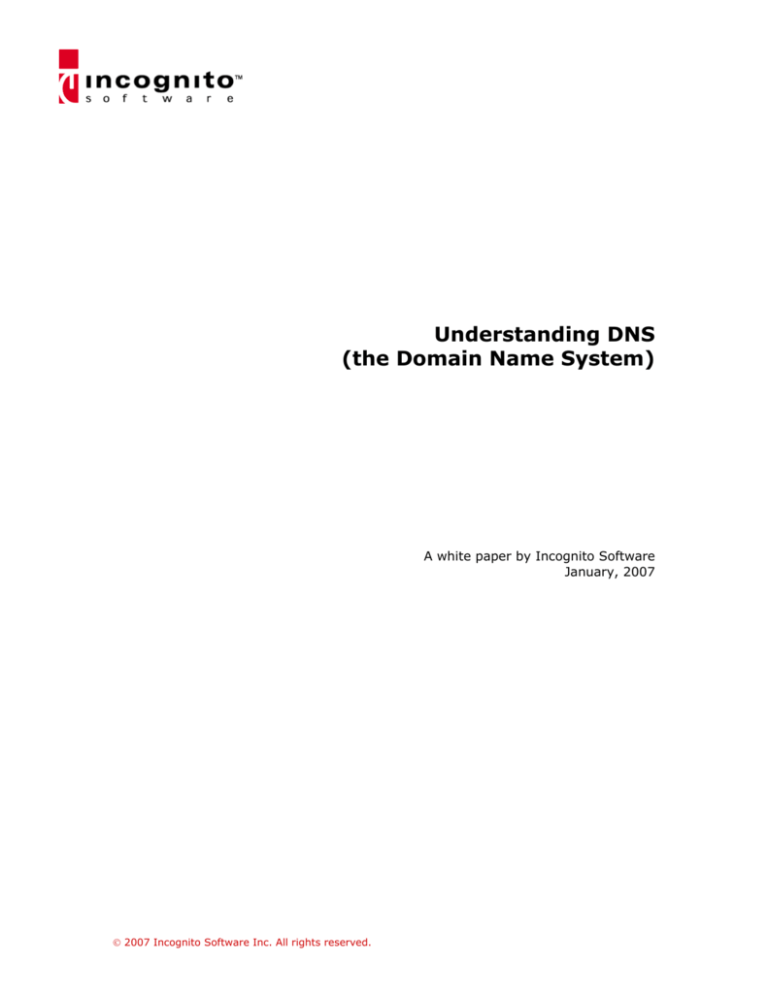
Understanding DNS
(the Domain Name System)
A white paper by Incognito Software
January, 2007
© 2007 Incognito Software Inc. All rights reserved.
Understanding DNS (the Domain Name System)
Introduction ............................................................................................................... 2
The Structure of a Domain Name System (DNS) .............................................................. 2
Domain Name Space.................................................................................................... 3
Zones .....................................................................................................................4
Resource Records (RRs) ............................................................................................5
Name Servers ............................................................................................................. 6
Primary Name Servers ..............................................................................................6
Secondary Name Servers ..........................................................................................6
Dynamic DNS (DDNS) ...............................................................................................6
Full Zone Transfer Process .........................................................................................7
Incremental Zone Transfer Process .............................................................................7
Domain Name Resolution.............................................................................................. 7
Resolvers ................................................................................................................7
Domain Name Resolution Process ...............................................................................7
Caching ..................................................................................................................8
Conclusion.................................................................................................................. 8
An effective
Domain Name
System (DNS) is
critical to Internet
access speeds.
Introduction
An effective Domain Name System (DNS) is critical to Internet
access speeds. The bandwidth of your Internet connection is
irrelevant if the DNS system is slow.
DNS is essentially the telephone directory of the Internet. Just as a
phone number such as 604-525-5555 is mapped to a name like
John Smith, every device that communicates over the Internet has
a unique, machine-readable IP address that is mapped to a humanreadable domain name such as www.incognito.com. If you need to
contact that device, you can use its domain name.
DNS supports high performance, availability, and scalability through
the use of data hierarchies, data replication, and caching.
The Structure of a Domain Name System (DNS)
DNS provides a name lookup facility that is similar to a standard
telephone directory. To perform lookups, DNS relies on a
distributed system of name servers and a standardized language to
query these servers. Each name server stores a portion of the
overall name space, and can contact other name servers to lookup
names outside its name space.
The three main components of a DNS system are:
•
Domain Name Space: defines the overall naming structure
of the Internet
© 2007 Incognito Software Inc. All rights reserved.
Page 2 of 8
Understanding DNS (Domain Name System)
The domain name
space defines the
overall naming
structure of the
Internet.
The domain name
of any node in the
tree is the
sequence of node
labels leading
from that node all
the way up to the
root domain.
•
Name Server: maintains a portion of the domain name
spaces, resolves lookups, and maintains a cache
•
Domain Name Resolution: maps a domain name to an IP
address
Domain Name Space
The domain name space defines the overall naming structure of the
Internet.
The name space is consists of a tree structure of domain names,
with a root domain at the top. Immediately below the root domain
are the major domains such as .com, .net, and .org. From these
domains, the name space can branch into multiple paths, with each
intersection point called a node and labeled with a simple name.
DNS processes a domain name from right to left, with the highestlevel node represented at the far right, and the lowest level node
at the far left. The node labels are separated by dots. Examples
include incognito.com, verisign.com, and dnscommander.com.
The domain name of any node in the tree is the sequence of node
labels leading from that node all the way up to the root domain.
The top-level node (appearing farthest to the right) identifies the
geography or purpose (for example, the nation covered by the
domain, such as .uk, or a company category, such as .com). The
second-level node (appearing second from the right) identifies a
unique place within the top-level domain.
Domain names can contain up to 255 characters consisting of:
characters A to Z, 0 to 9, and/or “-”; 63 characters per node; and
up to 127 node levels. To ensure that each node is uniquely
identified, DNS requires that sibling nodes - nodes that are
“children” of the same “parents” - be uniquely named. For
example, these “absolute” names are unique:
beckett.incognito.com and beckett.af.mil.
© 2006 Incognito Software Inc. All rights reserved.
Page 3 of 8
Understanding DNS (Domain Name System)
Zones
The name space
tree is subdivided into
zones. A zone
consists of a
group of linked
nodes served by
an authoritative
DNS name server.
As shown in the following diagram, the name space tree is subdivided into zones. A zone consists of a group of linked nodes
served by an authoritative DNS name server (the final authority in
providing information about a set of domains).
Diagram courtesy of www.wikipedia.org
A zone contains
domain names
starting at a
particular point in
the tree (“Start Of
Authority”) to the
end node or to a
point in the tree
where another
host has authority
for the names.
A zone contains domain names starting at a particular point in the
tree (“Start Of Authority”) to the end node or to a point in the tree
where another host has authority for the names.
For example, the top-level .gov domain has the subdomains
wa.gov, tx.gov, co.gov, for the states Washington, Texas and
Colorado. The .gov zone file contains pointers to the sources of
data for tx.gov, co.gov and wa.gov.
Similarly, if the wa.gov domain delegated authority for dol.co.gov
to the information system section of the Washington State
Department of Licensing, the zone file for wa.gov only contains a
pointer to the data source for dol.wa.gov.
© 2006 Incognito Software Inc. All rights reserved.
Page 4 of 8
Understanding DNS (Domain Name System)
Resource Records (RRs)
Each node in the tree has one or more resource records, which
hold information about the domain name (for instance, the IP
address of www.incognito.com).
RRs can store a
large variety of
information about
a domain: IP
address, name
server, mail
exchanger, alias,
hostname, geolocation, service
discovery,
certificates, and
arbitrary text.
RRs can store a large variety of information about a domain: IP
address, name server, mail exchanger, alias, hostname, geolocation, service discovery, certificates, and arbitrary text.
RRs contain information such as:
Start-of-Authority (SOA) Record
When a zone file indicates to a querying server that this is the
authoritative record for this domain, it says to the query, “You
Have Arrived”. The SOA contains the following data fields:
•
Serial Number: indicates number of changes to the zone
file. The number increases as the file is updated.
•
Refresh: tells the name server how often to check to update
its data
•
Retry: tells server when to return if it is unable to refresh
the data
•
Expire: tells how long the data can sit before it is too old to
be valid
•
Time to Live: tells other servers how long to cache the data
they have downloaded
Name Server (NS) Record
An NS record is a record that indicates which computer is to be
used to retrieve information about the domain name space for a
particular domain name. A Host Name Server contains information
about “your” computer and supplies IP addresses that are
associated with it.
Mail eXchange (MX) Record
MX records specify the mail server address for the domain name.
This record allows email addressed to a specific domain to be
delivered to the mail server that is responsible for it. The mail
server is a host address. There can be a number of mail servers
associated with a MX record. Each server has a priority set for mail
receipt.
Address (A) Record
This record tells the name server the correct IP address for the
domain. The name server that is authoritative for the domain
contains all the information necessary to resolve this name.
Canonical (C-NAME) Record
CName records provide name-to-name-to-IP address mapping for
any domain name aliasing. The difference between CNAME and “A”
records is that the CNAME resolves to another domain name that
then resolves to an IP address.
© 2006 Incognito Software Inc. All rights reserved.
Page 5 of 8
Understanding DNS (Domain Name System)
Name Servers
Name servers generally store complete information about a zone.
There are two types of name servers: primary and secondary.
Every zone MUST have its data stored on both a primary and a
secondary name server.
Primary Name Servers
Primary name servers hold “authoritative” information about set of
domains, as well as cached data about domains previously
requested from other servers.
Each name server
stores a portion of
the overall name
space (a zone
file), and can
contact other
name servers to
lookup names
outside its name
space.
Each name server stores a portion of the overall name space (a
zone file), and can contact other name servers to lookup names
outside its name space. The name server listens for DNS queries,
and if the queried name is in the local zone data or cache,
responds immediately with an answer. If the name isn’t in the local
database or cache, the server uses its “resolver” to forward the
query to other authoritative name servers.
If domain data changes, the primary name server is responsible for
incrementing the Serial Number field in the SOA record in order to
signal the change to secondary name servers.
Secondary Name Servers
Secondary name servers can download a copy of zone information
from a primary name server using a process called a “zone
transfer.”
Zone transfers allow secondary name servers to download
complete copies of zones. Secondary name servers perform “zone
transfers” according to the Expire Time parameter in the SOA
record.
Dynamic DNS (DDNS)
Over the last decade, the exponential increase in the number of
hosts on the Internet eventually uncovered two drawbacks with the
original DNS system.
First, changes to zone files would not take effect until the DNS
server was stopped and re-started. Second, primary name servers
could only update secondary servers through processes called zone
transfers. Traditional full zone transfers are inefficient because they
occur on a scheduled basis instead of occurring as changes are
made. These full transfers also involve transfer of all the records in
a zone regardless of how many are changed.
To address these problems, the IETF defined Dynamic DNS (DDNS)
protocol in RFC 2136, zone change notification in RFC 1996, and
incremental transfers in RFC 1995. DDNS allows DHCP servers to
send updates to primary DNS servers, removing the need for
administrator intervention. Additionally, when a change is made on
the primary server, a zone change notification is immediately sent
to the secondary servers, with only the changed records being
transferred.
© 2006 Incognito Software Inc. All rights reserved.
Page 6 of 8
Understanding DNS (Domain Name System)
Full Zone Transfer Process
To perform a zone transfer, the secondary name server queries the
primary name server to determine if any changes have been made
to the zone. The query is based on data in the primary server’s
SOA record: the Serial Number, and the interval specified by the
Minimum TTL value.
The secondary server downloads all RRs even if there are only a
few modified records. Primary and secondary name servers are
typically out of synchronization by approximately one hour.
Incremental Zone Transfer Process
If the primary name server supports the NOTIFY and Incremental
Zone Transfer (IXFR) protocol, then the primary name server can
NOTIFY the secondary name server that a portion of its data has
changed. After receiving the NOTIFY command, the secondary
name server can request only the data that has changed from the
primary using the IXFR command.
Domain Name Resolution
Resolvers
A resolver maps
a domain name
to the IP
address that
identifies its
hosted location.
Name servers are capable of retrieving data from both their
domain name spaces and other name servers’ domain name
spaces. This process is necessary to translate human-readable
domain names into machine-readable IP addresses.
When a name server acts as a “resolver,” it maps a domain name,
such as www.incognito.com, to an IP address that identifies the
domain’s hosted location. The resolver serves as a link between
two computers: the one requesting a domain’s IP address, and the
one holding that information. The resolver returns the domain’s IP
address to the computer that requested the information.
Domain Name Resolution Process
A name server
begins a search
by first checking
its own name
space. If the
queried domain
name is not part
of its space, the
name server then
issues a query to
a root name
server.
In order to resolve the IP address of a domain name, a name
server works on the domain name segment by segment, from
highest-level domain appearing on the right, to lowest-level
domain on the left. The resolver usually has to query several
servers that are authoritative for various portions of the domain
name to find all the necessary information.
A name server begins a search by first checking its own name
space. If the queried domain name is not part of its space, the
name server then issues a query to a root name server.
The root name server returns the names and addresses of the toplevel name servers (“referrals”) that are authoritative for the toplevel domain. Root name servers know where the authoritative
name servers are for all the top-level domains.
Next, the top-level name servers can provide the list of name
servers authoritative for the second-level domain. Each name
server queried provides the further information about how to get
“closer” to the location it is seeking.
© 2006 Incognito Software Inc. All rights reserved.
Page 7 of 8
Understanding DNS (Domain Name System)
Some resolvers can only communicate with a single name server.
These simple resolvers rely on a recursing name server to perform
the work of finding information for them.
Caching
One of the
inherent abilities
of DNS is the
ability to store
recently retrieved
domain names.
This is useful for
speeding up the
resolution
process.
One of the inherent abilities of DNS is the ability to store recently
retrieved domain names, a process called “caching.” This process is
useful for speeding up the resolution process.
Each time a name server “learns” the authoritative name servers
for a zone and the addresses of those servers, it can cache this
information to help speed-up subsequent queries. Thus, the next
time a resolver queries for the same domain name, the name
server is able to respond immediately because the answer is stored
in its cache.
Conclusion
A DNS system is a fundamental piece of the Internet framework.
The hierarchical structure of the DNS name space, worldwide
network of name servers, and efficient local caches allow broadband
operators to provide high-speed, user-friendly Internet
communications.
Contact:
Incognito Software Inc.
Phone: 604.688.4332 or US/Canada toll free 800.877.1856
Fax:
604.688.4339
Email: sales@incognito.com
Web: http://www.incognito.com
© 2006 Incognito Software Inc. All rights reserved.
Page 8 of 8







